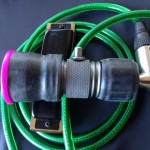“Hello, Tomlin from tomlinharmonicalessons.com here to give you a review of the Silverfish Ceramic Harmonica Mic .
Click here for a video review and sound sample – with Tomlin playing some cool blues harmonica riffs or here: Silverfish Review_2
” ..you can get some very tasty creamy overdrive without the annoying mid-range honk you get from a lot of microphones. So, you can really cover all the bases..”
“What does it sound like when you plug it in? The answer is, good and very versatile”
I am a full-time harmonica teacher and player based in Edinburgh, Scotland. I teach people all over the world through Skype and my online harmonica school. Personally, I play a lot of blues, Jazz, R&B and funk/soul which sees me playing in function bands, original bands as well as recording sessions.
The Silverfish Harmonica Mic III microphone is specifically designed for blues harmonica players and features a ceramic element which can go from clean to creamy overdrive. The first thing that is a big plus for me is how nice and compact the microphone is. I personally don’t have the biggest hands in the world and I often struggle with the typical harmonica mic; The Green Bullet. As a result, I normally use a stick microphone such as a Shure SM57. The reason that it is so important to have a microphone that fits your hand size is that you want to create an airtight seal around the harmonica and microphone in order to get the biggest “tone” you can. Already, without plugging in I could tell that the Silverfish would make it easy to get a decent seal.
Furthermore, it has a big advantage over the SM57 in that it is much lighter so you don’t get hand cramp after a long practice or performance. There are a couple of nice details which confirm that Rick knows what harmonica players want and need. For example, the volume knob is small and very firm which means you are not going to accidentally twist it in the middle of a particularly enthusiastic harmonica solo. Another nice detail is the rubber around the microphone element itself which serves two purposes. Firstly, it means that the harmonica isn’t going slip out of your hands when they get sweaty (a real issue!). Secondly, it also helps the airtight seal by making sure that no air can get out of the pop shield around the microphone element.
Okay, enough about the nice design!
What does it sound like when you plug it in?
The answer is, good and very versatile. It is naturally a very clean microphone but when you cup it tightly and with a little help from the amplifier you can get some very tasty creamy overdrive without the annoying (in my opinion) mid-range honk you get from a lot of microphones. So, you can really cover all the bases which is great for me as I will quite often find myself playing some old Chicago blues then some jazz standards in the same set.
Finally, it is so affordable that everyone should have one either as your only microphone harmonica or as a spare in your gig bag.”
Tomlin Leckie




